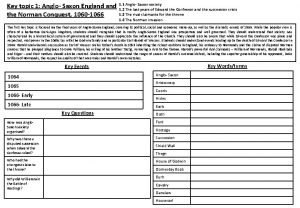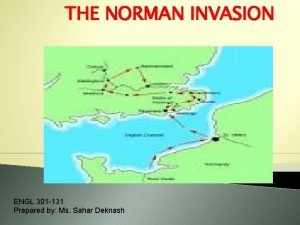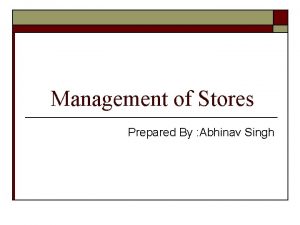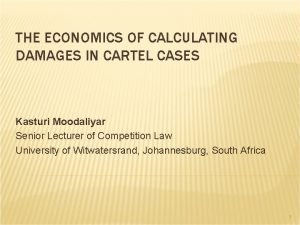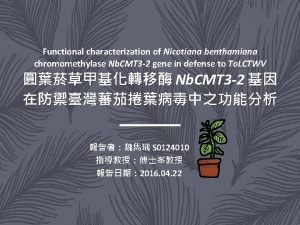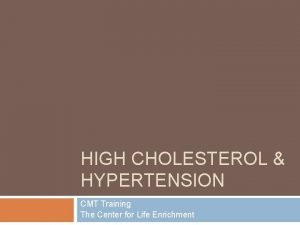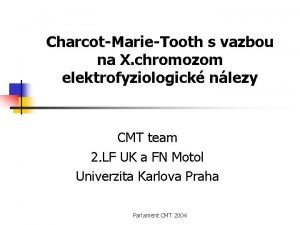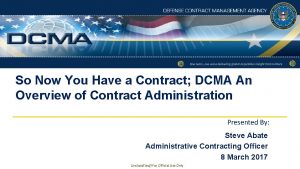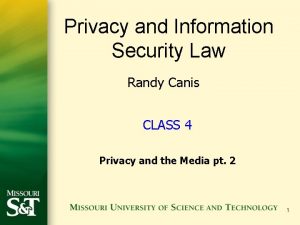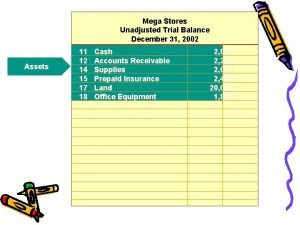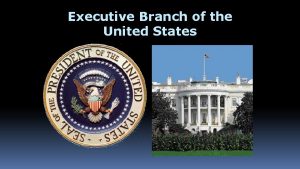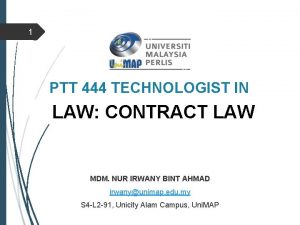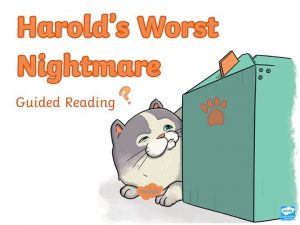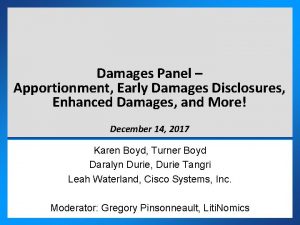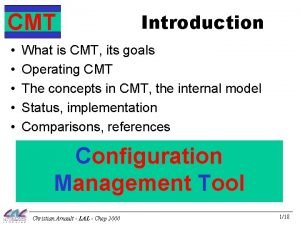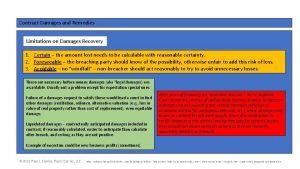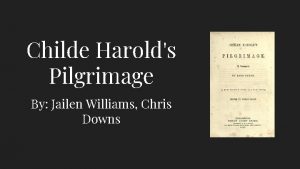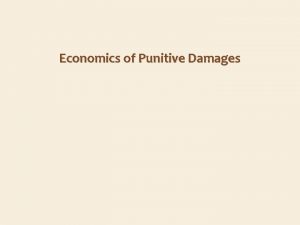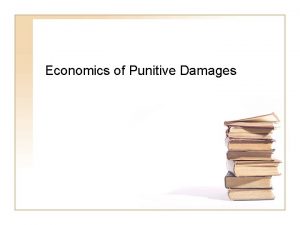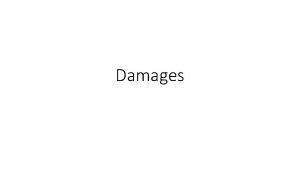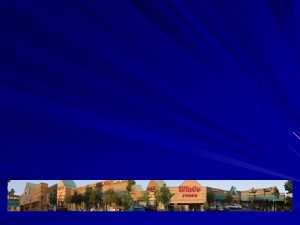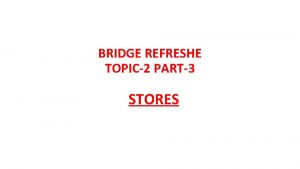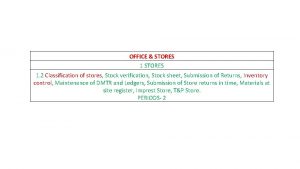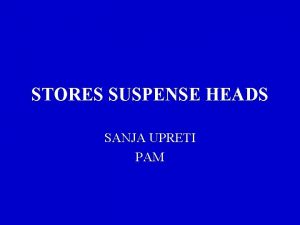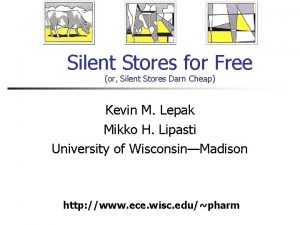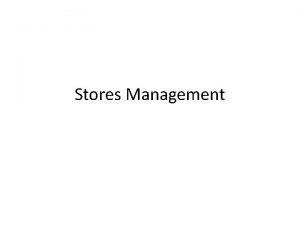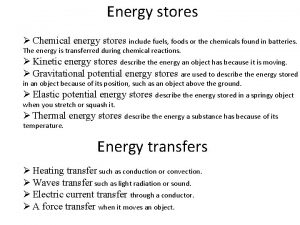Damages Chris Anthony Harolds Stores Inc and CMT



















- Slides: 19

Damages Chris Anthony

Harold’s Stores Inc. and CMT Enterprises Inc. v. Dillard Department Stores Inc. United States Court of Appeals, Tenth Circuit May 3, 1996

Facts • • • Harold’s, a retail clothing store located mainly in TX and OK, was in the practice of purchasing original art and developing print fabrics with it that were produced by CMT Harold’s represented to its customers that these garments were only available at Harold’s These garments made up 56% of Harold’s skirt sales, 40% of overall sportswear sales In 1993, Dillard offered for sale skirt sales with identical print patterns to those offered by Harold’s in 1991 and 1992 for significantly less ($78 -80 apiece vs. $28 -$30). After Harold’s filed its original complaint, Dillard redueced the prices to $12 or $12. 25, which was below cost. Before trial, Dillard stipulated that it had infringed 19 (on 37, 000 garments) of Harold’s patterns- the issue for the court was damages

Damages Award • • There was no claim that Dillard’s actions harmed Harold’s sales of the copied prints (Dillard’s didn’t offer the prints until after Harold’s had pulled them). Damages awarded for three claims: – Copyright infringement claim: $312, 000 (factors in damage to reputation, goodwill as well, reduced by court to $260, 220 to avoid double recovery) – OK Unfair Sales Act: $21, 780 – OK Antitrust Act: $30, 000 (trebled by court to $90, 000) • • Computation of damages relied largely on study of Dr. Daniel J. Howard Dillard objected to admission of Dr. Howard’s survey, claimed – 1) Dr. Howard failed to survey a relevant universe of consumers – 2) the survey was not material or probative to establish copyright damages

Survey Participants • • 1, 231 surveys collected from female undergraduates at SMU (44. 3% of undergraduate female population) No incentives Dillard complained that proper universe encompasses “Harold’s overall customers” (geographically and demographically) Harold’s claimed that they target the college market specifically, intentionally locating stores near campuses CEO claimed that buying patterns of college-age women were “identical to our older customers” Testimony before district court “established that purchasing patterns, consumer preferences, and the demand products were similar for all Harold’s, regardless of geographic location” Court accepted this


Survey Results • • Only respondents that answered “yes” to Questions 1 and 2 (578 0 r 48. 0%) were considered Question 4 was inserted to weed out unreliable or questionable respondents (asked about seeing purses with designs unique to Dillard’s, although there was no such thing) – 160 answered “yes” to Question 3, but this is reduced to 66 by removing those who said “yes” or “unsure” to Question 4 – Still leaves 66 (11. 5%) who responded “yes” to Question 3 but “no” to Question 4 • Howard compared “yes, no” group (3. 18 mean for likelihood to shop at Harold’s to 4. 75 for “no, no” group) – Howard says he wants to get rid of those who saw something that wasn’t there (purses), those who were unsure and whose ambiguity renders their judgment difficult to interpret in a comparative sense. – Among the groups Howard eliminated 4 of the 7 had higher scores than 4. 75, so this comparison doesn’t seem to benefit Harold’s

Howard’s Interpretation • • Takes the mean difference (33. 1%) as “an estimate of the proportional reduction in intentions of purchasing clothes at Harold’s withing the next year due to seeing the disputed skirts on sale at Dillard’s” Also looks at “negative word-of-mouth” effects – Past survey had estimated that 57% of dissatisfied customers complained – Assumes that hearing negative reports will have half the effect that observing the skirts • Considered men’s clothing as well – 55% purchased by women – 48% of other purchases (based on phone survey) influenced by women – Thus, Howard arrives at total of 76. 4% of men’s clothing estimated to be made by or influenced by women

Short-Term Damages Model • • • Short-Term Damages= (the relevant proportion of consumers who observed Dillard’s attempted sale of the disputed skirts) X (the resuilting proportional reduction in their intentions of purchasing clothing at Harold’s withing the next year) X (the proportion of variation in behavior explained by purchase intentions) X (an appropriate sales figure for Harold’s) X (the relevant maintained markup) + (the relevant proprtion of consumers who received negative word-of-mouth information about Harold’s because of Dillard’s attempted sale of the disputed skirts) X the resulting proportional reduction in their intentions of purchasing clothing at Harold’s within the next year) X (the proportion of variation in behavior explained by purchase intentions) X (an appropriate sales figure for Harold’s) X (the relevant maintained markup) Estimate for women’s clothing: $51, 675 Estimate for men’s clothing: $28, 536

Long-Term Damages Model • • • Calculated for three ensuing years Assumes effects fade over time, but still remain Assumes that each year, the effect will be half of the preceding year, discounts for advertising budget Long-term damages estimate for women: $42, 767 Long-term damages estimate for men: $23, 617 Howard admits that he has greatest confidence in short-term damages for women, least for long-term damages for men

Damage Estimates Attributable to Price Reduction • • Argument is that the cheap price offered by Dillard led to consumers downgrading their evaluation of the value for their money obtained by shopping at Harold’s Lower price utilized for approximately 30% of time in question – Howard says that lower price more likely to attract attention, do more damage – Thus, assumes that 50% of the damage is from this time period – Concludes that 20% of damage ($29, 318) can be attributed to lower-price period

Dillard Specific Objections • • • 1) Question four on the survey- the “filter question”- rendered the survey inadmissible 2) The survey was fatally flawed because it did not mimic market conditions 3)The survey was inadmissible because it did not refer to the copyrighted fabric designs 4) The survey questions were slanted, leading and ambiguous Court declines to rule survey inadmissible, saying that “deficiencies in the survey bear on the weight and not the admissibility of the evidence”

Other Possible Objections • • • Doesn’t consider that people may shop at Harold’s but not Dillard People who answered “yes, no” seem to be more perceptive shoppers, which suggests a difference in the two groups beyond what they’ve been exposed to at the different stores Taking survey likely to incite people’s emotions about being ‘duped’ (possibly what Dillard refers to in 4 th objection)

In re Chevron U. S. A. Inc • United States Court of Appeals, Fifth Circuit, March 26, 1997

Facts • • • P’s contend that their subdivision was constructed on land used in the 1920’s by Chevron for a crude storage pit Alleged that Chevron failed to take appropriate measures to secure the site, thereby allowing other waste to be deposited on the land Chevron later sold the property for residential development P’s assert that hazardous substances which were stored in the waste pits have migrated into the environment, including the drinking water P’s (over 3, 000) claim personal injury and property damage

Court’s “bellwether” plan • • • Because of large number of plaintiffs, the district court established a plan for a “unitary trial” on the issues of “general liability or causation” on behalf of the remaining plaintiffs, as well as the individual causation and damages issues of the selected plaintiffs Bellwether group of 30 claimants, 15 chosen by P’s and 15 by Chevron P’s chose 15 P’s who were seriously ill, Chevron chose 15 who didn’t seem to be harmed Chevron contended that the goal of the “unitary trial” was to determine its liability, or lack thereof, in a single trial and to establish bellwether verdicts to which the remaining claims could be matched for settlement purposes (trial court doesn’t actually explain exactly how verdicts for 30 P’s are supposed to establish liability for 2970 others) Selection process is what Chevron argues with- says it will not result in a representative group of bellwether plaintiffs

Chevron’s objection • • • Submitted to trial court the affidavit off Ronald G. Frankiewicz, Ph. D Frankiewicz concluded that plan was “not representative” Detailed “stratified selection process” that should be used instead to result in a representative group of P’s Frankiewicz’s plan involved “smaller groups according to (I) primary medical complaint and (II) severity of the medical condition” which would be sampled at random Rejected by district court as untimely filed and redundant in substance Files petition for mandamus with Appeals Court

Appeals Court Response • • Says there is no pretense that the 30 P’s are representative Because of this, the court can’t draw sufficiently reliable inferences Sample must be random to have value Not fair to base the outcome on an unrepresentative sample However, court says that unitary trials with bellwether plaintiffs could be appropriate Doesn’t force district court to adopt stratified system, but bars use of 15/15 system Concurrence doesn’t “share… confidence that bellwether trials can be used to resolve mass tort controversies”

Faulk, Meadows, Colbert paper • • • Danger of district court’s plan was that it could become a “hammer for imposing an unjust settlement” Risk of all-or-nothing from unitary trial with unrepresentative sample If done incorrectly, conducting a unitary trial with bellwether plaintiffs would basically be equivalent to sanctioning a de facto premature class -action
 Harolds mistakes in the battle of hastings
Harolds mistakes in the battle of hastings Harolds mistakes in the battle of hastings
Harolds mistakes in the battle of hastings Centralized stores with sub-stores
Centralized stores with sub-stores Before and after method damages
Before and after method damages Cmt-3
Cmt-3 čmt meso
čmt meso Cmt-3
Cmt-3 Siemens cmt
Siemens cmt Foods to avoid with cmt
Foods to avoid with cmt Cmt
Cmt Cmt sample questions
Cmt sample questions Dcma boston
Dcma boston Pure coaching academy
Pure coaching academy Cmt project
Cmt project Swot swarovski
Swot swarovski Jordan v jewel food stores inc
Jordan v jewel food stores inc Ottawit mega stores inc
Ottawit mega stores inc The damages of the bureaucracy political cartoon meaning
The damages of the bureaucracy political cartoon meaning Ld damage
Ld damage Ptt 444
Ptt 444
